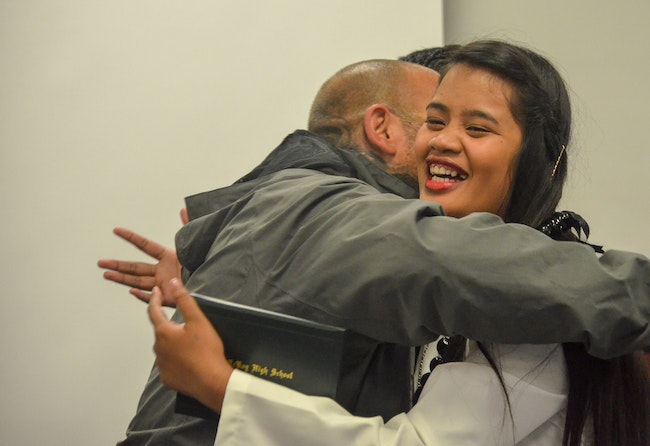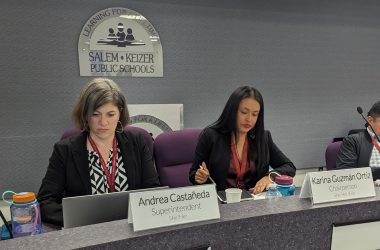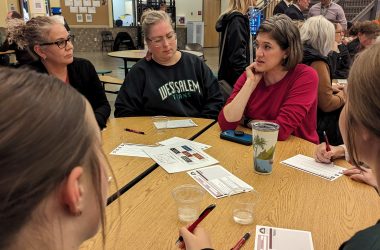 Ruth Langmoir, an August 2019 McKay High School graduate, gets a hug from graduation coach Ken Ramirez after earning her diploma. (Rachel Alexander/Salem Reporter)
Ruth Langmoir, an August 2019 McKay High School graduate, gets a hug from graduation coach Ken Ramirez after earning her diploma. (Rachel Alexander/Salem Reporter)
The percentage of Salem-Keizer students earning a high school diploma climbed again last year, marking a steady increase from five years ago.
More than 2,400 students walked across the graduation stage in 2019, giving the district a 79% graduation rate, according to state data released Thursday. That’s up from 76% in 2018, and 72% five years ago.
“It felt really, really awesome to see that our strategies are starting to work,” said Superintendent Christy Perry.
(Graphic by Rachel Alexander/Salem Reporter)
High school graduates are much more likely to be employed than those who don’t finish school, and less likely to end up in prison or jail.
Salem-Keizer’s improvement is similar to the state figures. Oregon’s 2019 graduation rate was 80% and has steadily increased over the past five years.
The local gains include nearly every group of students. Black, Pacific Islander and Native American students all graduated at much higher rates in 2019 than 2018, with Pacific Islander students nearly at the district average. Those three ethnic groups have historically had the lowest graduation rates from local high schools.
Of the 21 categories of students that Oregon tracks, only homeless students in the Salem area did worse in 2019, with just under half graduating in four years.
Though they posted gains, students with disabilities still graduate at a much lower rate than the district average. In 2019, 62% earned a diploma in four years. About one in three of those received a modified diploma, an option available to students with significant barriers to learning.
Students who aren’t proficient in English by high school continue to struggle, with about half graduating on time in 2019. That’s up from 40% in 2018.
(Graphic by Rachel Alexander/Salem Reporter)
Perry said there’s still work to be done. But the improvement reflects efforts at each school and districtwide work to help specific groups of students with historically low graduation rates.
“Every school has a little different strategy,” she said.
West, Sprague and McNary high schools recorded graduation rates above 90%.
For 2019, North’s graduation rate decreased one percentage point, to 76%, still far higher than it was in 2017, when it was 68%.
“We knew we were going to be pretty flat because we had a huge gain the year before,” said Principal Sara LeRoy. “Now the hard work for us is really, really starting.”
LeRoy said North has worked to keep kids engaged in school even if they don’t finish in four years. The school’s five-year graduation rate went up significantly to 84% last year, higher than the district number.
“We didn’t give up on kids. We were continuing to work with them,” she said.
(Graphic by Rachel Alexander/Salem Reporter)
Starting in 2018, LeRoy and other school employees identified students who could graduate but were likely to struggle because they were slipping on the necessary credits or failing classes. McKay undertook a similar effort.
Both schools paired students with a staff member they trusted to help get them across the finish line, whether a teacher, coach or security guard.
Both principals credited that effort to improving graduating rates last year. McKay again improved in 2019, with 84% of students graduating on time.
READ: North, McKay see gains by targeting struggling seniors
Last year, South Salem High School adopted a similar system, principal Lara Tiffin said. Her staff identified 72 students who could graduate but might not make it because of academic challenges or issues in their personal lives.
“They build on relationships that they had already developed,” she said. In some cases, that involved “absolutely all-out nagging” from staff. Those employees earned extra pay for the hours they worked outside the school day, with the money coming from a state fund to improve graduation rates.
The work also meant creative problem-solving. If a student was failing a class needed to graduate while earning an A in something they didn’t, teachers might suggest pulling them from the class they were doing well in to take two periods of their weaker subject, Tiffin said.
Ultimately, all but one of those students went on to earn a diploma: two in summer school, and the rest during their senior year.
“There were so many people walking across the stage that we knew wouldn’t have made it without that boost,” Tiffin said.
Reporter Rachel Alexander: (503) 575-1241 or [email protected]

Rachel Alexander is Salem Reporter’s managing editor. She joined Salem Reporter when it was founded in 2018 and covers city news, education, nonprofits and a little bit of everything else. She’s been a journalist in Oregon and Washington for a decade. Outside of work, she’s a skater and board member with Salem’s Cherry City Roller Derby and can often be found with her nose buried in a book.









